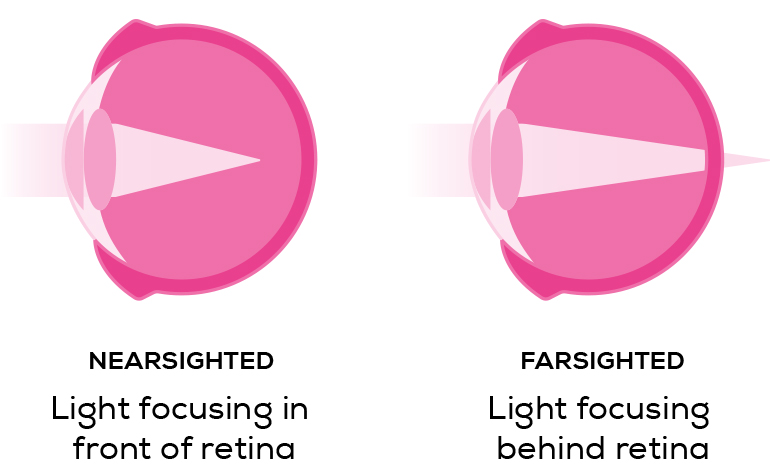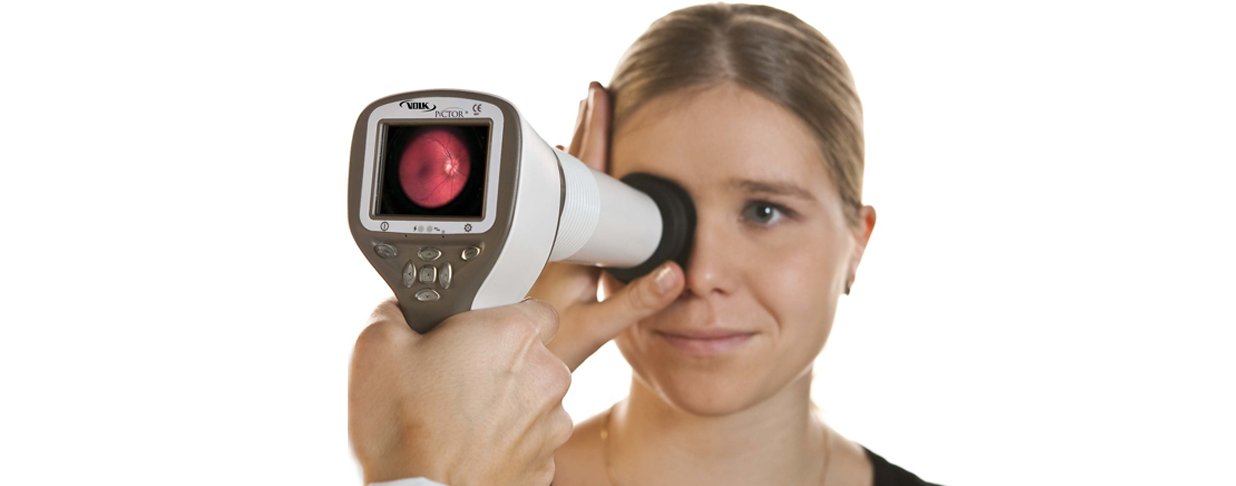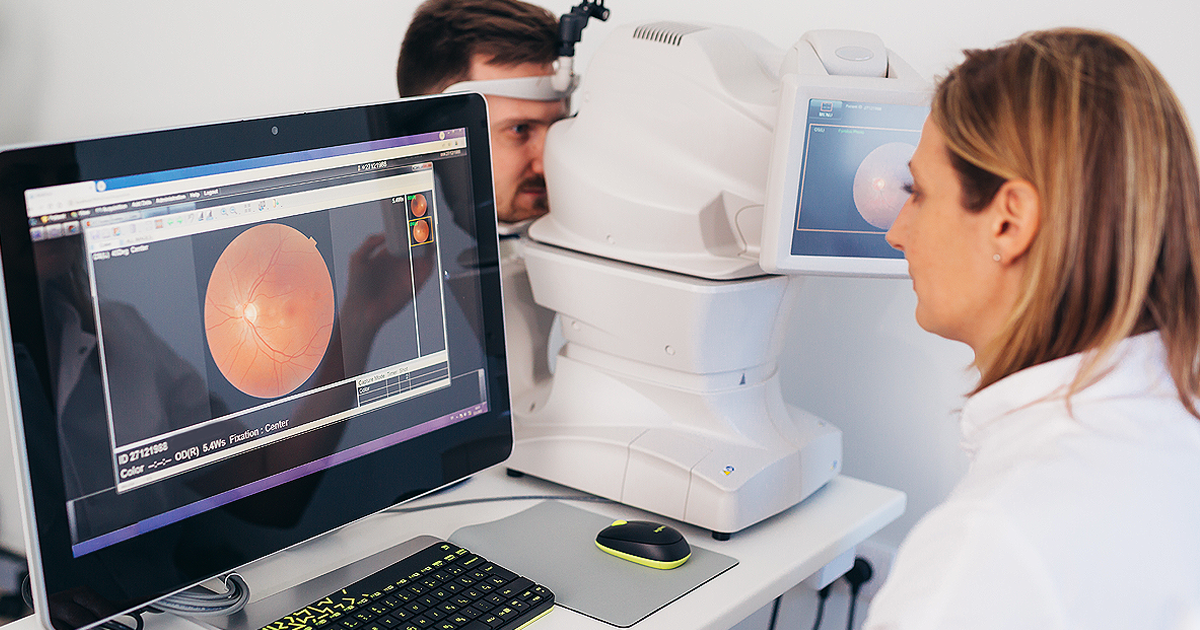Nearsightedness and farsightedness are two of the most common vision issues affecting people all over the world. In fact, half the global population is projected to be nearsighted by 2050,1 and 5-10% of Americans currently have farsightedness.2 But how do each of those conditions affect the eye, and what can be done to treat it?

How the eye works
To have clear vision, any light entering the eye must land, or focus, on the retina at the back of the eye. But when the shape of the eye causes the light to focus in front of or behind the retina, the result is blurry vision—that is, either nearsightedness or farsightedness.
Nearsightedness
Nearsightedness, or myopia, occurs when light coming into the eye focuses in front of the retina instead of directly on it. Far-away objects appear blurry, while objects closer to the eye look clearer.
Causes
Light focuses in front of the retina when the eye is elongated or the cornea is too steep, but what causes those changes is still unknown. Nearsightedness tends to begin in children, and certain habits can make it worse, like reading without breaks or looking at smart devices up close for long periods of time. Spending time outdoors in natural light is one of the ways to reduce the risk of myopia and reduce its progression to higher levels.3
Signs and symptoms
In addition to far-away objects looking blurry and close-up objects looking clear, other symptoms of myopia include:
- Eye strain and eyes that feel fatigued
- Squinting
- Headaches
- Eye rubbing
- In children, trouble concentrating or needing to sit close to the front of the classroom
Treatment
Eye doctors can test for nearsightedness at annual eye exams. The test may result in a prescription—a numeral representing the strength of the lens needed to correct myopia for glasses or contacts. Hard contact lenses used at night (called orthokeratology) can also be used to help reshape the cornea. To permanently correct nearsightedness and eliminate the need for corrective lenses, laser surgery is also an option. During laser surgery, the cornea is reshaped so that the light entering it lands correctly on the back of the retina.
---------------
EssilorLuxottica is developing lens technologies that are helping slow the progression of childhood myopia.
Click here to learn more about Stellest and SightGlass innovations.
Farsightedness
Farsightedness, or hyperopia, is the exact opposite of nearsightedness—light coming into the eye focuses too far beyond the retina instead of directly on it. It makes things far away appear clear, while objects closer to the eye look blurry.
Causes
Issues with the cornea or an eye that grows too short from front to back can contribute to farsightedness. Due to the flexibility of the eye in young people, many children are farsighted (in fact, most infants are farsighted)4, but may not have symptoms. They may not need glasses, or they may outgrow farsightedness—but still need to see an eye doctor. Untreated farsightedness can worsen and lead to amblyopia (lazy eye) or vision loss.5
Farsightedness is also a normal part of aging. Presbyopia—gradually losing the ability to read things up close around or after age 40—occurs as the eye becomes more rigid, making it more difficult to change shape to focus on things far away instead of up close. While there’s no way to stop presbyopia’s progression, it can be corrected with progressive eyeglasses or contacts, or even surgery.6
Signs and symptoms
Besides close-up objects looking blurry and far-away objects looking clear, signs of being far-sighted include:
- Eye strain and eyes that feel fatigued
- Headaches
- Difficulty writing or reading books or screens
- Difficulty with depth perception
Treatment
Like myopia, eye doctors can test for hyperopia at annual eye exams. The test may result in a prescription, which can be used to get the right corrective glasses or contact lenses. To permanently correct farsightedness and eliminate the need for corrective lenses, laser surgery is also an option. During laser surgery, the cornea is reshaped so that the light entering it lands correctly on the back of the retina.
Can you be nearsighted and farsighted?
While it’s rare to be both nearsighted and farsighted, it is possible. A condition called anisometropia refers to differing refractive errors in each eye, but when one eye is nearsighted and one is farsighted, it’s called antimetropia.7 You cannot be nearsighted and farsighted in the same eye.
Learning more
For more resources on nearsightedness and farsightedness, contact your EyeMed representative or visit eyemed.com.
••••
1 Thomson, E.; “Why short-sightedness is on the rise and what can be done”; World Economic Forum; weforum.org; November 2, 2022.
2 “Nearsightedness vs Farsightedness: How to Tell the Difference”; Vision Center; visioncenter.org; Updated December 1, 2022.
3 McManes, A.; “What causes nearsightedness (myopia)?”; All About Vision; allaboutvision.com; Updated March 3, 2022.
4 Altshul, S.; “What Is Hyperopia (Farsightedness)? Symptoms, Causes, Diagnosis, Treatment, and Prevention”; Everyday Health; everydayhealth.com; Reviewed May 26, 2021.
5 Porter, D.; “Farsightedness: What Is Hyperopia?”; American Academy of Opthalmology; aao.org; August 4, 2022.
6 Boyd, K.; “What Is Presbyopia?”; American Academy of Ophthalmology; aao.org; November 22, 2022.
7 “Anisometropia”; Cleveland Clinic; clevelandclinic.org; Reviewed October 4, 2022.




